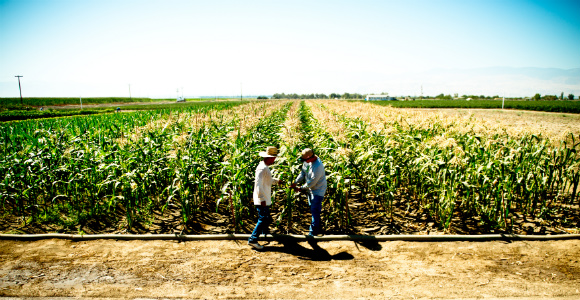
Farm workers in Bakersfield. (Photo Credit: Violeta Vaqueiro)
Blessed with a Mediterranean climate larger than the actual Mediterranean, California produces over half of US consumed fruits, nuts and vegetables. California is also a worldwide leader in renewable energy. And now a new alliance is inviting the largest ag state, to combine what they produce best, agriculture and clean energy. By adapting to climate change, it’s 80,500 farms and ranches could become smart climate agriculture global heroes.
“California could be at the forefront of this movement. If the world can get to where we are, and we are always moving forward, that is a great place to be,” said A.G. Kawamura, co-founder of Solutions From The Land, former Secretary of California Department of Food and Agriculture, produce farmer, and also co-lead of the Summit’s Working Landscapes Action Team.
The North American Smart Climate Agriculture Alliance, created by Solutions From The Land, will bring together farmers, ranchers and foresters to collaborate with industry experts. The focus will be on sustainability, resilience to climate change, reducing greenhouse gasses and reviewing the latest scientific evidence of climate change.
“Whether you believe in climate change or not we need to adapt to these things that are unprecedented,” said Ernie Shea, president of Solutions From The Land.
Those challenges come in the form of shorter harvesting windows, shorter planting windows, storms and precipitation that causes damage to machinery and crops, not to mention three-year California drought, which will cost the state an estimated 2.2 billion and 17,000 jobs.
“All of these things farmers worry about because they have to figure out how to adapt,” said Shea. “What is science telling us? We did a review of science-based studies that confirmed more of this is coming. So what are we going to do about it?”
The Alliance produced a report that suggests 50 adaptations including drip irrigation for drought protection, the gasification of walnuts, and solar power.
For Maddox Farms in Riverdale, California, solar has been cost effective, efficient and–bonus–contributes to the Central Valley’s desperate need for cleaner air. Solar powers 80 percent of Stephen Maddox Jr.’s dairy.
“We are always open to adapting new technologies that make sense and are win-win for us,” said Maddox. “We all (farmers) want to be better stewards of the land and air.”
California is also the largest dairy state in the country. Kawamura says if dairies can realize benefits to the ecosystem, they will see economic benefits.
“If suddenly dairy products that were once perceived to be sent to the dump, now go to help the environment, people are inspired to buy these products,” said Kawamura.
At the end of the day, agriculture is a big business in California with roughly a $44 billion farm gross value. According to development experts, this number could grow if farmers and ranchers adopted renewable energy tactics. Take, for example, cows that produce milk and manure. Regardless of the price of milk going up and down, manure (a waste cost) could be turned into renewable energy for profit.
“If you create an incentive for the use of new renewable energy technology, you are going to get a triple bottom line benefit,” said Robert Tse, development specialist at USDA California Rural Development. “It would give farmers a source of revenue that is not linked to the cost of agricultural products.”
The Alliance will collaborate with the federal government and state legislatures to implement smart climate agricultural incentives. However, the alliance is the first of its kind in that it is farmer led.
“That is why we grew so quickly. There is more confidence in farmer leaders generating the discussion than government agencies,” said Shea.
The discussion could be the impetus for California becoming the leading state in smart climate agriculture. By managing the land sustainably and strengthening the economy in unison, California could become an ecosystem pioneer.
“For most parts of the world, it’s getting hotter and dryer…and California is a perfect application of smart climate agriculture because we are already a hot and dry state,” said Tse. “California could be the pilot for everything applied globally, all for California’s own economic benefit.”

